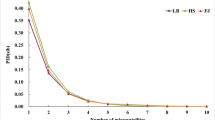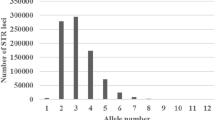Abstract
Yunnan snub-nosed monkeys (Rhinopithecus bieti) are 1 of 3 snub-nosed monkey species endemic to China. Only ca. 1500 individuals remain in high-altitude forests 3000–4500 m above sea level on the Tibetan Plateau, making them the nonhuman primate living at the highest known elevation. It is one of the most endangered 25 primate species in the world. Proper knowledge of the population genetics and social system of Rhinopithecus bieti will contribute to more appropriate conservation management decisions. Cross-species amplification of human microsatellite loci has facilitated analysis of the population genetics and reproductive strategies of various primate species. We screened 72 human-derived markers to assess their utility in Yunnan snub-nosed monkeys. Thirteen of them produced reliable results and exhibited moderate levels of polymorphism.
Similar content being viewed by others
References
Bonhomme, M., Blancher, A., & Crouau-Roy, B. (2005). Multiplexed microsatellites for rapid identification and characterization of individuals and populations of Cercopithecidae. American Journal of Primatology, 67, 385–391.
Bradley, B. J., Boesch, C., & Vigilant, L. (2000). Identification and redesign of human microsatellite markers for genotyping wild chimpanzee (Pan troglodytes verus) and gorilla (Gorilla gorilla gorilla) DNA from faeces. Conservation Genetics, 1, 289–292.
Chambers, K. E., Reichard, U. H., Moller, A., Nowak, K., & Vigilant, L. (2004). Cross-species amplification of human microsatellite markers using noninvasive samples from white-handed gibbons (Hylobates lar). American Journal of Primatology, 64, 19–27.
Clisson, I., Lathuilliere, M., & Crouau-Roy, B. (2000). Conservation and evolution of microsatellite loci in primate taxa. American Journal of Primatology, 50, 205–214.
Deuter, R., Pietsch, S., Hertel, S., & Muller, O. (1995). A method for preparation of fecal DNA suitable for PCR. Nucleic Acids Research, 23, 3800–3801.
Edwards, A., Civitello, A., Hammond, H. A., & Caskey, C. T. (1991). DNA typing and genetic mapping with trimeric and tetrameric tandem repeats. American Journal of Human Genetics, 49, 746–757.
Ellsworth, J. A., & Hoelzer, G. A. (1998). Characterization of microsatellite loci in a New World primate, the mantled howler monkey (Alouatta palliata). Molecular Ecology, 7, 657–659.
Hadfield, R. M., Pullen, J. G., Davies, K. F., Wolfensohn, S. E., Kemnitz, J. W., Weeks, D. E., et al. (2001). Toward developing a genome-wide microsatellite marker set for linkage analysis in the rhesus macaque (Macaca mulatta): Identification of 76 polymorphic markers. American Journal of Primatology, 54, 223–231.
Jablonski, N. G. (1998a). The evolution of the doucs and snub-nosed monkeys and the question of the phyletic unity of the odd-nosed colobines. In N. G. Jablonski (Ed.), The natural of the doucs and snub-nosed monkeys (pp. 13–52). Singapore: World Scientific Publishing.
Jablonski, N. G. (1998b). The response of catarrhine primates to Pleistocene environmental fluctuations in East Asia. Primates, 39, 29–37.
Kanthaswamy, S., Dollen, V. A., Kurushima, J. D., Alminas, O., Rogers, J., Ferguson, B., et al. (2006). Microsatellite markers for standardized genetic management of captive colonies of rhesus macaques (Macaca mulatta). American Journal of Primatology, 68, 73–95.
Kohn, M. H., & Wayne, R. K. (1997). Facts from feces revisited. Trends in Eco1ogy & Evolution, 12, 223–227.
Lathuilliere, M., Menard, N., Gautier-Hion, A., & Crouau-Boy, B. (2001). Testing the reliability of noninvasive genetic sampling by comparing analyses of blood and fecal Samples in Barbary Macaques (Macaca sylvanus). American Journal of Primatology, 55, 151–158.
Launhardt, K., Epplen, C., Epplen, J. T., & Winkler, P. (1998). Amplification of microsatellites adapted from human systems in faecal DNA of wild Hanuman langurs (Presbytis entellus). Electrophoresis, 19, 1356–1361.
Laurent, E., Guillaume, L., & Stefan, S. (2006). Arlequin ver 3.01: An integrated software package for population genetics data analysis. Available at: http://cmpg.unibe.ch/software/arlequin3.
Li, B. G., Pan, R. L., & Oxnard, C. E. (2002). Extinction of snub-nosed monkeys in China during the past 400 years. International Journal of Primatology, 23, 1227–1244.
Long, Y. C., Kirkpatrick, C., Zhong, T., & Xiao, L. (1994). Report on the distribution, population, and ecology of the Yunnan snub-nosed monkey. Primates 35, 241–250.
Monteiro, L., Bonnemaison, D., Vekris, A., Petry, K. G., Bonnet, J., Vidal, R., et al. (1997). Complex polysaccharides as PCR inhibitors in feces: Helicobacter pylori model. Journal of Clinical Microbiology, 35, 995–998.
Morin, P. A., Kanthaswamy, S., & Smith, D. G. (1997). Simple sequence repeat (SSR) polymorphisms for colony management and population genetics in rhesus macaques (Macaca mulatta). American Journal of Primatology, 42, 199–213.
Newman, T. K., Fairbanks, L. A., Pollack, D., & Rogers, J. (2002). Effectiveness of human microsatellite loci for assessing paternity in a captive colony of vervets (Chlorocebus aethiops sabacus). American Journal of Primatology, 56, 237–243.
Oka, T., & Takenaka, O. (2001). Wild gibbons’ parentage tested by non-invasive DNA sampling and PCR-amplified polymorphic microsatellites. Primates, 42, 67–73.
Quan, G. Q., & Xie, J. Y. (2002). Research on the golden monkey. Shanghai: Science and Education Publishing House.
Raymond, M., & Rousset, F. (1995). GENEPOP, version 1.2: Population genetics software for exact tests and ecumenicism. Journal of Heredity, 86, 248–249.
Rogers, J., Mahaney, M. C., Witte, S. M., Nair, S., Newman, D., Wedel, S., et al. (2000). A genetic linkage map of the baboon (Papio hamadryas) genome based on human microsatellite polymorphisms. Genomics, 67, 237–247.
Sambrook, J., Fritsch, E. F., & Maniatis, T. (1989). Molecular Cloning: a Laboratory Manual, 2nd edn. New York: Cold Spring Harbor Laboratory Press.
Smith, D. G., Kanthaswamy, S., Viray, J., & Cody, L. (2000). Additional highly polymorphic microsatellite (STR) loci for estimating kinship in rhesus macaques (Macaca mulatta). American Journal of Primatology, 50, 1–7.
Witte, S. M., & Rogers, J. (1999). Microsatellite polymorphisms in Bolivian squirrel monkeys (Saimiri boliviensis). American Journal of Primatology, 47, 75–84.
Zhong, F., Brady, A. G., Shi, J., Abee, C. R., McCombs, C. C., & Michalski, J. P. (1996). Strategy using pooled DNA to identify 56 short repeat polymorphism for the Bolivian squired monkey. BioTechniques, 21, 580–586.
Acknowledgments
The National Basic Research Program of China (973 Program: 2007CB411600), the National Science Foundation of China (30630016 and 30570292), the Innovation Project of the Chinese Academy of Sciences (KSCX2-YW-R-091), and Jiangsu Key Laboratory for Biodiversity and Biotechnology provided funding for this project. We thank Prof. Michael W. Bruford (Cardiff University, U.K.) for technical guidance and data analysis, and Drs. X. J. Zhan, L. F. Zhu, and M. Lu for their laboratory assistance. We express special thanks to Dr. Z. J. Zhang, Beijing Zoo and Beijing Endangered Animal Breeding Center (Daxing, Beijing) for providing Yunnan snub-nosed monkey samples.
Author information
Authors and Affiliations
Corresponding author
Rights and permissions
About this article
Cite this article
Liu, Z.J., Ren, B.P., Hao, Y.L. et al. Identification of 13 Human Microsatellite Markers via Cross-species Amplification of Fecal Samples from Rhinopithecus bieti . Int J Primatol 29, 265–272 (2008). https://doi.org/10.1007/s10764-007-9175-z
Received:
Accepted:
Published:
Issue Date:
DOI: https://doi.org/10.1007/s10764-007-9175-z




